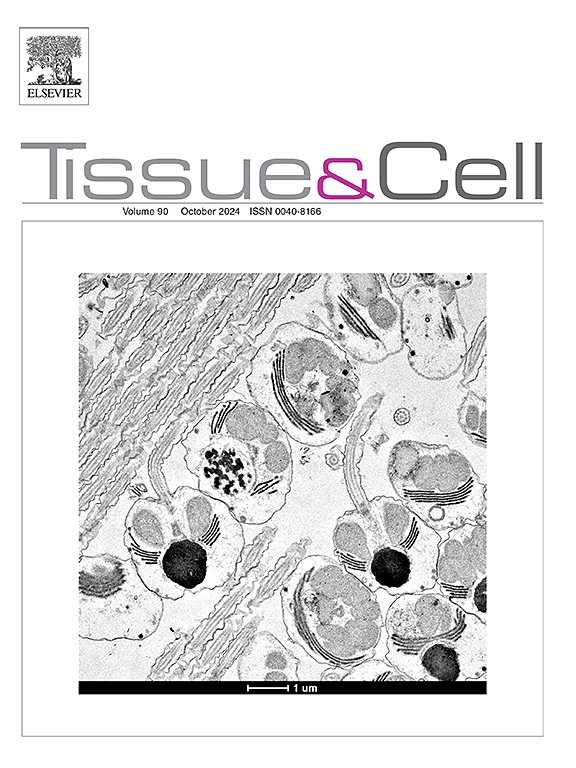番茄红素通过抑制氧化和神经炎症信号减轻阿尔茨海默病大鼠模型的认知功能障碍
IF 2.7
4区 生物学
Q1 ANATOMY & MORPHOLOGY
引用次数: 0
摘要
氧化应激和神经炎症是包括阿尔茨海默病(AD)在内的神经退行性疾病发展的关键因素。在动物模型中,番茄红素(LYC)已被证明在抑制炎症和氧化应激标志物方面具有有效性,并似乎对与AD相关的几种生理途径、行为表现和认知症状发挥调节作用。在本研究中,通过每天口服75 mg/kg水合氯化铝(AlCl₃·6H₂O) 6周,建立了雄性Wistar白化大鼠AD模型。Morris水迷宫(Morris water maze, MWM)行为测试证实实验组大鼠存在记忆障碍和认知衰退。表现出认知功能障碍的动物随后口服LYC(5 mg/kg)治疗6周,然后在牺牲前进行第二次MWM测试。结果显示,LYC显著提高AD模型大鼠的运动能力和认知功能,并显著(p <; 0.001)降低淀粉样蛋白β1-42、促炎介质[白细胞介素-1β (IL-1β)和肿瘤坏死因子α (TNF-α)]、丙二醛(MDA)和亚硝酸盐水平的积累。此外,LYC显著(p <; 0.001)降低了乙酰胆碱(ACh)浓度、单胺氧化酶(MAO)、肌酸激酶(CK)和乳酸脱氢酶(LDH)活性。此外,LYC显著(p <; 0.001)提高了乙酰胆碱酯酶(AChE)活性、核因子红细胞2相关因子2 (Nrf2)、血清素、抗炎介质[转化生长因子β -1 (TGF-β1)和白细胞介素-10 (IL-10)]水平、超氧化物歧化酶(SOD)和谷胱甘肽过氧化物酶(GPx)活性。LYC的治疗效果进一步得到了脑组织组织病理学外观的改善,突触素免疫组化表达显著(p <; 0.001)增强,细胞周期相关蛋白(Ki67和增殖细胞核抗原[PCNA])免疫组化表达的抑制。综上所述,LYC可能是一种很有前景的治疗AD的药物,它针对多种致病机制。本文章由计算机程序翻译,如有差异,请以英文原文为准。
Lycopene alleviates cognitive dysfunctions in an Alzheimer's disease rat model via suppressing the oxidative and neuroinflammatory signaling
Oxidative stress and neuroinflammation are key contributors to the development of neurodegenerative disorders, including Alzheimer's disease (AD). Lycopene (LYC) has demonstrated effectiveness in inhibiting inflammatory and oxidative stress markers and appears to exert a modulatory impact on several physiological pathways, behavioral manifestations, and cognitive symptoms associated with AD in animal models. In the present study, an AD model was established in male Wistar albino rats through daily oral administration of hydrated aluminum chloride (AlCl₃·6H₂O) at a dose of 75 mg/kg for six weeks. A Morris water maze (MWM) behavioral test was conducted to confirm memory impairment and cognitive deterioration in the treated rats. Animals exhibiting cognitive dysfunction were subsequently treated with LYC (5 mg/kg orally) for an additional six weeks, followed by a second MWM test before sacrifice. The findings revealed that LYC significantly enhanced performance and cognitive function in the AD model rats and markedly (p < 0.001) reduced the accumulation of amyloid β1–42, proinflammatory mediators [interleukin-1 beta (IL-1β) and tumor necrosis factor-alpha (TNF-α)], malondialdehyde (MDA), and nitrite levels. Furthermore, LYC significantly (p < 0.001) decreased the acetylcholine (ACh) concentration, monoamine oxidase (MAO), creatine kinase (CK), and lactate dehydrogenase (LDH) activites. Additionally, LYC significantly (p < 0.001) increased the acetylcholinesterase (AChE) activity, nuclear factor erythroid-2-related factor 2 (Nrf2), serotonin, anti-inflammatory mediators [transforming growth factor beta-1 (TGF-β1) and interleukin-10 (IL-10)] levels, superoxide dismutase (SOD), and glutathione peroxidase (GPx) activities. The therapeutic efficacy of LYC was further supported by improvements in the histopathological appearance of brain tissues, significant (p < 0.001) enhancement of synaptophysin immunohistochemical expression, and suppression of the immunohistochemical expression of cell cycle-related proteins (Ki67 and proliferating cell nuclear antigen [PCNA]). In conclusion, LYC may represent a promising therapeutic agent for AD by targeting multiple pathogenic mechanisms.
求助全文
通过发布文献求助,成功后即可免费获取论文全文。
去求助
来源期刊

Tissue & cell
医学-解剖学与形态学
CiteScore
3.90
自引率
0.00%
发文量
234
期刊介绍:
Tissue and Cell is devoted to original research on the organization of cells, subcellular and extracellular components at all levels, including the grouping and interrelations of cells in tissues and organs. The journal encourages submission of ultrastructural studies that provide novel insights into structure, function and physiology of cells and tissues, in health and disease. Bioengineering and stem cells studies focused on the description of morphological and/or histological data are also welcomed.
Studies investigating the effect of compounds and/or substances on structure of cells and tissues are generally outside the scope of this journal. For consideration, studies should contain a clear rationale on the use of (a) given substance(s), have a compelling morphological and structural focus and present novel incremental findings from previous literature.
 求助内容:
求助内容: 应助结果提醒方式:
应助结果提醒方式:


